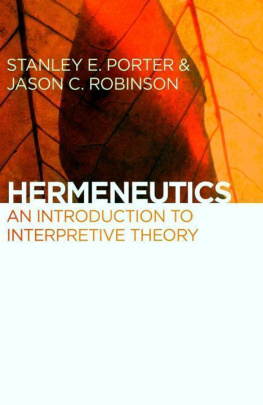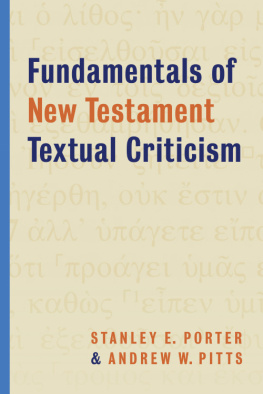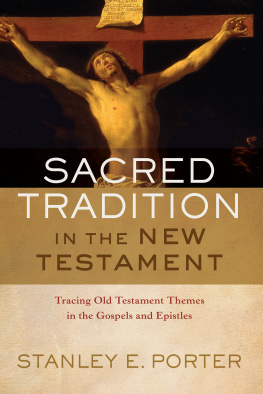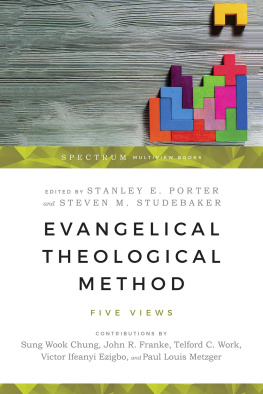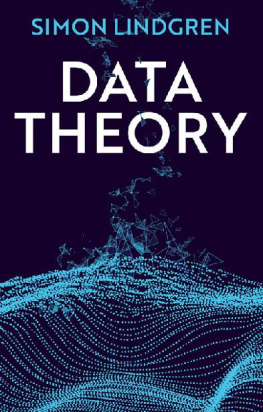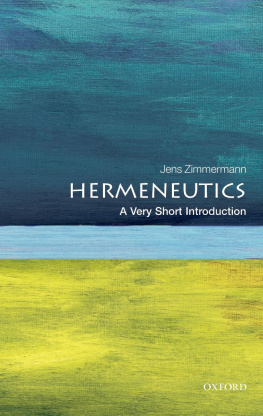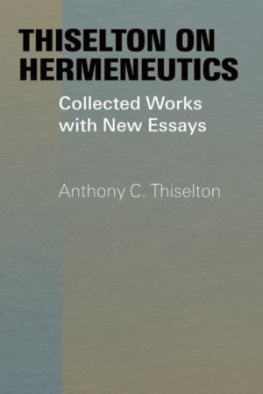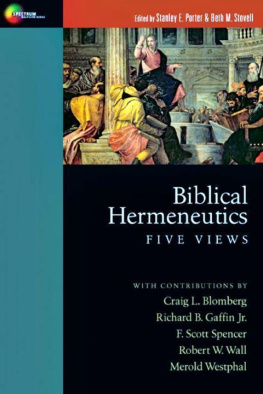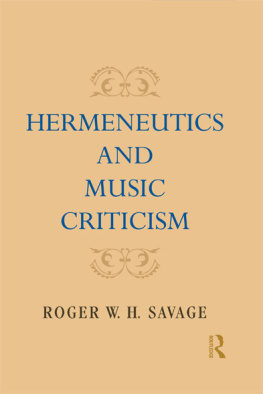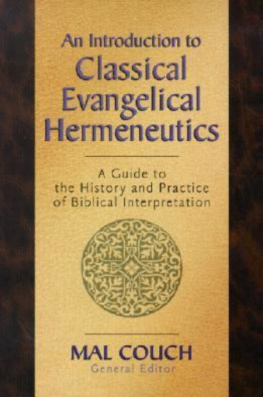Stanley E. Porter - Hermeneutics: An Introduction to Interpretive Theory
Here you can read online Stanley E. Porter - Hermeneutics: An Introduction to Interpretive Theory full text of the book (entire story) in english for free. Download pdf and epub, get meaning, cover and reviews about this ebook. year: 2011, genre: Religion. Description of the work, (preface) as well as reviews are available. Best literature library LitArk.com created for fans of good reading and offers a wide selection of genres:
Romance novel
Science fiction
Adventure
Detective
Science
History
Home and family
Prose
Art
Politics
Computer
Non-fiction
Religion
Business
Children
Humor
Choose a favorite category and find really read worthwhile books. Enjoy immersion in the world of imagination, feel the emotions of the characters or learn something new for yourself, make an fascinating discovery.
- Book:Hermeneutics: An Introduction to Interpretive Theory
- Author:
- Genre:
- Year:2011
- Rating:5 / 5
- Favourites:Add to favourites
- Your mark:
- 100
- 1
- 2
- 3
- 4
- 5
Hermeneutics: An Introduction to Interpretive Theory: summary, description and annotation
We offer to read an annotation, description, summary or preface (depends on what the author of the book "Hermeneutics: An Introduction to Interpretive Theory" wrote himself). If you haven't found the necessary information about the book — write in the comments, we will try to find it.
Hermeneutics: An Introduction to Interpretive Theory — read online for free the complete book (whole text) full work
Below is the text of the book, divided by pages. System saving the place of the last page read, allows you to conveniently read the book "Hermeneutics: An Introduction to Interpretive Theory" online for free, without having to search again every time where you left off. Put a bookmark, and you can go to the page where you finished reading at any time.
Font size:
Interval:
Bookmark:

Stanley E. Porter & Jason C. Robinson
"What man needs is not just the persistent posing of ultimate questions, but the sense of what is feasible, what is possible, what is correct, here and now."
HANS-GEORG GADAMER, Truth and Method (trans. Joel Weinsheimer and Donald G. Marshall [2nd rev. ed.; New York: Continuum, 2002], xxxviii)
xiv
xvi
We wish to acknowledge first of all those who have had the most significant influence upon our interest in hermeneutics and interpretation.
Stanley Porter wishes to acknowledge the influence of a number of important teachers from whom he has learned much and benefited greatly. These include: Dr. Noel Fitch, Dr. Glenn Sadler, and Dr. William Spengemann in literary criticism; Prince and Whittemore in philosophy; Mr. Nigel J. C. Gotteri in linguistics; and Dr. Grant Osborne and Professor Anthony Thiselton in general hermeneutics. He also wishes to thank a number of colleagues who through conversation and other means have had significant influence upon his thought in these areas through the years. These include Dr. Dennis L. Stamps, Dr. Stephen Fowl, Dr. Mark Brett, Professor Markus Bockmuehl, Professor Arthur Gibson, Dr. David Rhoads, Professor Francis Watson, and Dr. Mark Boda. Dr. James Peterson and Dr. Andrew Gabriel each helpfully read one of the chapters, and Dr. Matthew Malcolm provided several useful insights. Porter also wishes to acknowledge the constructive input of a number of students and former students in his classes, hermeneutical or otherwise, who have helped him to think through such interpretive and hermeneutical issues. These include Dr. Jeffrey T. Reed, Dr. Scott Berthiaume, John Wesley Reed, Scot Snyder, Dr. Brook W. R. Pearson, Dr. Kent Clarke, Dr. Matthew Brook O'Donnell, Christopher Land, Jan Nylund, Beth Stovell, Brad Williams, who helped with research, and Andrew W Pitts, who read through the entire manuscript and offered many valuable suggestions, and provided important research help. Porter would finally like to thank the stu dents who have studied with him in various hermeneutics and related interpretation courses at various educational institutions where he has had the privilege to teach.
Jason Robinson wishes to thank Dr. Richard N. Longenecker and Dr. Stanley E. Porter for challenging his early interpretive views. He remembers having once delivered a seminar paper on the role of experience in art and theology, after which Stan asked simply, "Why have you accepted that particular hermeneutical approach over the others?" This was a disturbing question that troubled him - though he would never admit as much to Stan - for it became clear that he had not spent enough time looking at his own interpretive theory in a broader context. He also wishes to thank those who, through institutional and personal connections, introduced him directly to the Gadamerian and larger hermeneutical tradition. These include those he studied with at master's and doctoral level, including Dr. Jeff Mitscherling, Dr. Jay Lampert, and Dr. John Robertson. He wishes to thank all of them for the lessons they shared with him.
On a more personal level, we would like to thank those closest to us for their unstinting support. Stan would like to thank his wife, Wendy, for being a constant source of encouragement and help in enabling him to carve out time for completion of such a project, as well as reading it through in its entirety and making many helpful suggestions of content and style. Thanks! Jason wishes to thank his wife, Cynthia, for her unending editorial support on all his hermeneutics projects, including countless hours of reading and rereading the many drafts of this manuscript, and for being his life partner - that we are on this journey together makes me infinitely grateful.
Our hope and desire is that this book will be a fitting tribute to those who have helped us in our own hermeneutical thought, and an aid to others as they develop in theirs.
This project came about as the result of our common interests in hermeneutics and interpretive theory. Collaborative work on a dictionary of criticism and interpretation led to further discussion about possible research topics in the area of hermeneutics. After discussion of a range of potential topics, we decided to collaborate on this book to bring together recent hermeneutical and interpretive thought in a single critical introductory volume. One of the major ambitions of this volume was to create a constructive bridge between European hermeneutical foundations, especially though not exclusively in the work of a number of German thinkers, and recent North American hermeneutics, including biblical hermeneutics and literary theory. The mix of figures and topics might strike some as unusual in that it gives roughly equal significance to many of the giants of Western intellectual thought and contemporary authors whose work is still in progress. These are areas that are usually kept apart and not brought into interpretive dialogue in a single volume such as this one. Even some very recent treatments have emphasized contemporary continental thought, but at the expense of not giving equal weight to the North American and English-language tradition. This volume is not an inclusive survey that runs the risk of moving too quickly over the surface of admittedly complex issues and ideas, or a specialized volume on a single topic that lacks the kind of breadth required by the topic, but a volume that provides critical analysis of (admittedly restricted) major movements and figures in hermeneutics and interpretive theory in the modern era, especially as these interpreters and movements have had an impact on biblical and theological study. This resulting effort has been collaborative in every sense of the word.
In planning the content of this volume, we readily noted that there were a number of major figures who had to be included in such a work, especially those thinkers who had had wide and sweeping influence on philosophy and hermeneutics. The more difficult task was to determine those other figures and movements that had had significant, and in some ways even equivalent influence. Some of these have become even more important in recent areas of applied hermeneutics. We recognize that there are other movements we could have included, but we believe the ones we have selected and exposited are those that continue to be productively utilized or responded to in continuing hermeneutical thought. Even after having determined all of the movements, within some of these it was difficult to focus on the one or two most significant figures for presentation. One of the criteria we used was the enduring significance of the contributor's thought, in terms of other thought being based upon, responding to, or being derivative from such a figure. We realize that some may object to several of our choices, but we believe each one is justifiable because of their individual and abiding contribution. Even though it may appear strange to treat a number of living scholars along with some of the giants of hermeneutical thought, we have weighed those figures discussed in this volume and believe their work merits their treatment here, as they represent schools of thought not represented as well by others. We also know that we have had to leave out many important thinkers. Our only excuse is that we believe we have included others equally as significant. We believe that we have reached a unique balance and synthesis of hermeneutical work represented in this volume. Our goal has been to present each of the movements included here by representing it in terms of the thought of the most significant figure or figures who represent that thought. We have chosen to do so not by simply quoting the individual authors at great length, as is done in some roughly equivalent hermeneutical works, but by analyzing and then synthesizing relatively large quantities of material so that the major ideas of their proponents are presented. We have provided useful and in some instances relatively comprehensive bibliographies to guide readers to our sources of information and further sources that can provide more detailed primary and secondary discussion. Virtually all of this secondary literature - due to the projected audience of the book - is in English, although these volumes often include reference to important material in other languages. Most of the positions and proponents included have application to a wide range of hermeneutical thought, but we have especially included those who have had a direct and immediate impact on the field of theology and biblical interpretation. The history of modern hermeneutics began with theological reflection, and in this volume we continue to discuss it in terms of its use in the broader field of theology.
Font size:
Interval:
Bookmark:
Similar books «Hermeneutics: An Introduction to Interpretive Theory»
Look at similar books to Hermeneutics: An Introduction to Interpretive Theory. We have selected literature similar in name and meaning in the hope of providing readers with more options to find new, interesting, not yet read works.
Discussion, reviews of the book Hermeneutics: An Introduction to Interpretive Theory and just readers' own opinions. Leave your comments, write what you think about the work, its meaning or the main characters. Specify what exactly you liked and what you didn't like, and why you think so.

